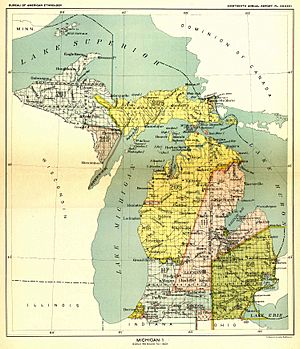Baw Beese facts for kids
Quick facts for kids
Baw Beese
|
|
|---|---|
| Potawatomi leader | |
| Personal details | |
| Born | c. 1790 |
| Died | c. 1850 Adrian, MI; Georgian Bay, Ontario; or Miami County, Kansas |
| Children | Winona |
Baw Beese (born around 1790, died around 1850) was an important Potawatomi Native American chief. He led a group of people who lived in the area that is now Hillsdale, Michigan, in the United States. Their main camp was by a large lake, which was later named Baw Beese Lake by the new settlers. In November 1840, Baw Beese and his people were forced to move far away to a new area called Indian Territory in Kansas. This happened because of a law called the Indian Removal Act of 1830.
Contents
The Potawatomi People
Before the 1821 Treaty of Chicago, Baw Beese led a group of Potawatomi people. There were more than 150 members in his group. They had lived on these lands near the large lake for a long time. They grew corn, hunted animals, and fished in the lake.
Other chiefs from Baw Beese's family lived in nearby areas of Michigan, Ohio, and Indiana. The Potawatomi people were known for being friendly to the new settlers who arrived. They even helped the settlers survive during their first years in the area.
Forced to Move
In November 1840, Baw Beese and his group were forced to leave Michigan. The U.S. Government made them move to a special area called a reservation in Miami County, Kansas. This was part of the Indian Removal Act. This law was signed by President Andrew Jackson in 1830.
Earlier agreements, like the Treaty of Fort Meigs of 1817 and the Treaty of Chicago of 1821, had suggested Native Americans might move voluntarily. But the Indian Removal Act made these moves mandatory. The U.S. military was used to make sure people left their homes.
A Chief's Justice
Baw Beese was known as a chief who believed strongly in justice. There is a story about his daughter, Winona. She was said to have killed a person named Neganska because he sold her pony. According to the story, Winona was then executed by a member of her husband's family. As chief, Baw Beese did not stop this from happening.
The Legend of Winona
The story of Baw Beese and his daughter Winona has become a local legend. In some versions of the story, Chief Baw Beese himself has to carry out the punishment for his daughter. Other versions say that Winona's bones were found near Baw Beese Lake. They were supposedly identified by a cross with her name on it.
Where Did Baw Beese Die?
The exact story of Baw Beese's death is not clear. One account says he moved to Adrian, Michigan in 1864 and died there in 1889.
However, other stories say he died in a different way. Some believe he died in Canada, in the pine forests near Georgian Bay, after leaving the reservation. Other accounts suggest he was killed in a fight with the Sioux people. Still others say he simply died of old age on the Kansas reservation, where the Potawatomi were finally settled.
Treaties and Land
Baw Beese himself never signed a treaty with the United States. However, he did follow the rules of the Treaty of Detroit from 1807. This treaty set a boundary line between the settlers and Native Americans. This line was between what are now Lenawee and Hillsdale counties. Because of this treaty, Baw Beese welcomed white settlers to Hillsdale County. But he saw them as people who were just renting the land.
The 1817 Treaty of Fort Meigs said that the Potawatomi would give up the southern part of Hillsdale County. This included important places for Baw Beese's family, like Bird Lake and Squawfield. But Baw Beese does not seem to have been part of this treaty. Other chiefs he knew were also not listed on it.
A name similar to Baw Beese, "Paw-pee," appears on a treaty from 1834. But it is unlikely to be Chief Baw Beese. He was often connected with other chiefs like Me-te-au, Ne-au-to-beer-shaw (also called "Leather Nose"), and Wap-ka-zeek. None of these chiefs are listed on that 1834 document.
Places Named After Him
- Bawbeese Lake in Hillsdale, Michigan
- Chief Baw Beese Chapter of the North Country Trail


